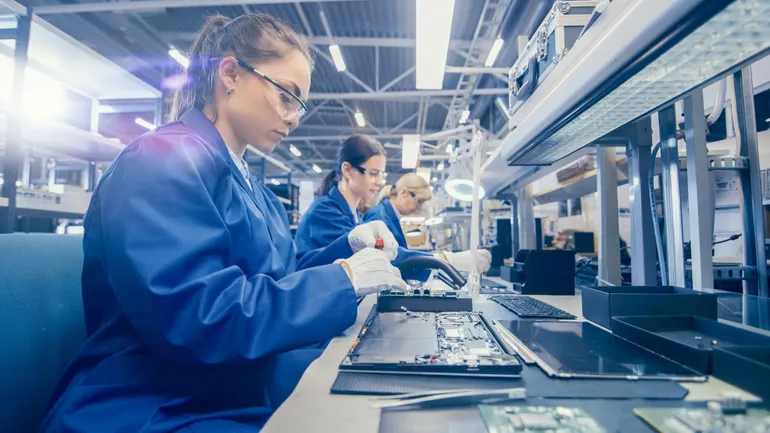Chemical safety nonprofit ChemForward has partnered with Apple on a search tool that helps formulators of cleaners and degreasers replace high-hazard chemicals with safer, vetted alternatives to reduce exposure for workers.
Dubbed the ingredient optimization application, the free, web-based tool allows users to search for ingredients by function, ranging from antimicrobials to surfactants. It also provides access to verified chemical hazard data, including physical properties and hazard levels identifiers, as well as regulatory red flags.
Apple is one of nine consumer electronics members of ChemForward’s safer chemistry collaborative, which assesses the human and environmental impacts of specific chemical substances, said Stacy Glass, ChemForward’s executive director. Some of the group’s priorities include PFAS replacements and optimizing device coatings.
Workers use cleaners and degreasers to remove contaminants, such as dust and fluids, during electronics or semiconductor manufacturing, so as not to interfere with production. This work constantly exposes employees to industrial solvents, which are made with harmful chemicals such as benzene, methanol, xylenes and trichloroethylene that could cause cancer, irritation and other illnesses, according to the Clean Electronics Production Network. Apple is also a member of CEPN’s network.
The application came about about two years ago as part of Apple’s commitment to worker safety, Glass said. The iPhone maker established internal programs and processes to safeguard employees, and it took a “proactive” approach by ensuring the cleaners they use were as safe as possible.
For Apple’s part, the iPad maker supplied the common ingredients — or chemical hazard assessments — archive used in cleaning formulations so that individuals and smaller companies don’t have to do the work, Glass said.
“Many hundreds of thousands of dollars” went to the development, Glass said, which went into creating the toxicology data. An investment was not disclosed, and Apple did not respond to multiple requests for comment.
However, the data sharing model was implemented with the full support of ChemForward stakeholders, said Bill Walsh, fund director of the Safer Chemistry Impact Fund. The nonprofit also considered that the hazardous chemicals’ functions are used in other industries as well.
“The goal is to not have the data disappear, be behind some regularly expensive paywall, or only be made available to select clients,” Walsh said. “We want this really to be like a library.”
IBM, another member of ChemForward’s safer chemistry collaborative, also assisted with the development by looking at the chemical’s structure, Glass said. Earlier this year, IBM developed and implemented an artificial intelligence-powered PFAS screener tool that helps identify and eliminate fluorochemicals from its research operations.
The PFAS screener tool was accelerated with the launch of ChemForward’s “PFACTS,” a collaboration led by IBM Research and involving Cornell University, Digital Science, Numat and the University of Pittsburgh. The ongoing project was funded by the National Science Foundation in December 2023 and developed a resource for anyone seeking to replace, redesign or remediate forever chemicals.
The ingredient optimization application identifies ingredients approved by chemical and environmental assessment programs such as GreenScreen Certified, ToxFMD and the U.S. EPA’s Safer Choice. Users can also manage electronics safety guidelines, such as the standard for green cleaners used, which the Global Electronics Association launched in 2022 and Apple product manufacturer Foxconn helped develop.
ChemForward utilizes these screening programs as an “easy button” for manufacturing, supply chain and procurement leaders, especially if they do not know anything about chemistry, Glass said.
What ChemForward and its collaborators learned during development is that formulators and manufacturers encountered barriers in their search for certified cleaners and degreasers, Glass added.
“The first thing we did was we developed the tool called Clean Screen, which is just a rapid screening for formulation,” Glass said. Formulators can use the free web-based tool by entering all of their ingredients into the application, which comprises a shared archive of broad chemical hazard data, according to the website.
If a chemical is a “likely candidate” for certification, ChemForward will set formulators up with a certifier, Glass added.
“If there’s something that needs to be optimized in their product, we then give them access to the ingredient optimization platform,” Glass said. Formulators can go in and find a safer surfactant or solvent, or the information needed to develop chemicals for “humans and the environment from a health and safety perspective.”
While there are restricted substances or a do-not-use list, it can lead to “regrettable substitutions” if a chemical is not on those lists but is just as bad, Glass said.
“The things that get looked at for those bad lists are known or suspected hazards,” Glass added. “What those lists can’t do is help the formulators know what to use instead, and what they need to be able to know where to go instead is this comprehensive toxicology information, and that’s ChemForward’s sweet spot.”
The nonprofit plans to focus on tool adoption for the next year, in an effort to learn whether the screeners are getting embedded in the electronics supply chain, as well as remove “any other friction” identified and improve as more users sign up to use free, web-based tools, Glass said.
